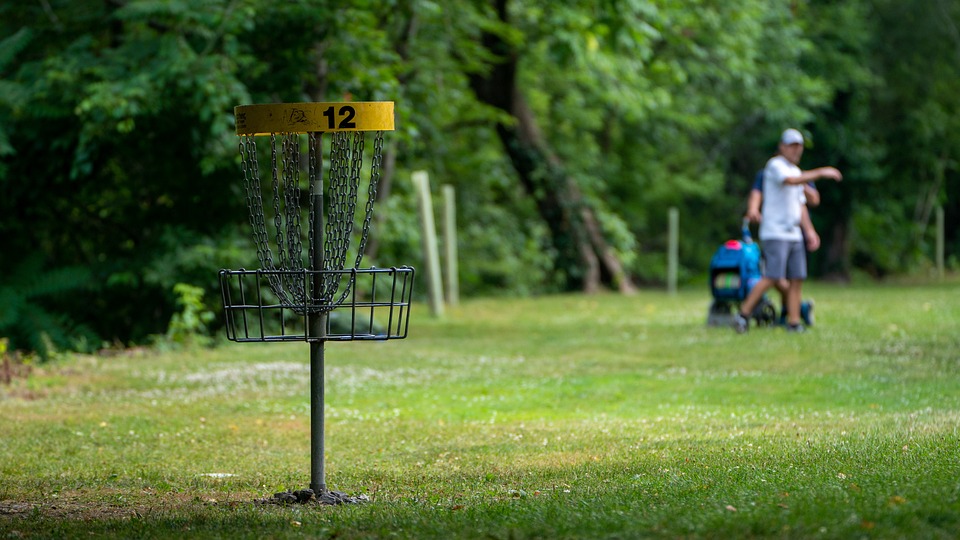Longmont sees a future with more parks and more pickleball, too
On a breezy and warm spring day Thursday, Amy Sindler and roughly a dozen members of the Longs Peak Disc Golf Club used Loomiller Park’s disc golf course for practice — hurling the discs artfully toward their targets.
Soaring through the air, the colorful discs landed with a rattle as they struck the chain baskets.
Sindler is the vice president of the club, which got its start in 2001. For the group, Longmont parks are more than a place to hone their craft and host tournaments — they’re a place to make memories with their friends and family and make the sport visible to the community.
Sindler said she loves seeing people at Longmont’s parks, whether they’re playing disc golf with the crew, riding their bikes or walking their dogs.
“People come to the parks because they’re so nice and well kept up,” Sindler said. “It’s a great way to spend your day.”
More parks planned
Fortunately for Sindler and all of Longmont’s residents, the future of the city includes more parks.
David Bell, Longmont’s Natural Resources manager, said the city has 42 parks, with two more — Nino Gallo and Clover Meadows — on the horizon.
When Bell thinks about the future of Longmont’s parks, he’s hopeful that in the next 10 years the city will see at least one new park every other year. After Nino Gallo and Clover Meadows, he said city staff members hope to begin design work in 2023 on Future Park, just north of the Jimm Hamm Nature Area.

Renewals and expansions of current parks are also on the agenda, including design work next year to expand Sandstone Ranch Park. Other future upgrades include additional trails and amenities at McIntosh Lake; a trail planned around Union Reservoir, as well as upgrades to amenities; and an expansion of Quail Campus community park, to name a few.
Creating more parks means finding out what residents want to see, while also looking at older parks and how amenities can be repurposed for multiple uses to accommodate different forms of recreation.
“Park trends ebb and flow,” Bell said. “If we hear from the community through email or through our Parks and Recreation Advisory Group, we’re always going to see if something that maybe isn’t getting the use it had at one point … can be looked at for an alternative.”
Bell said that whenever the city plans a new park, the process includes hiring a consultant.
“Then the consultants usually bring back three designs,” Bell said. “We go back to the community and say, ‘Which of these works best for you?’”
When it comes to amenities, the first thing the public is asking for is pickleball, Bell said. The city has 10 pickleball courts: six at Hover Park, two at Collyer Park and two at Clark Centennial. Two more are planned at Nino Gallo Park.
Other common requests are for new athletic fields, roller hockey rinks and BMX and skate parks. He’s seen other trends such as paddleboarding also popping up in places such as McIntosh Lake and e-bikes along the greenway.
Some examples of converting park amenities to multiple uses are adding pickleball lines to tennis courts. In the last year, he said the city implemented this in Collyer Park and Carr Park. Tennis courts were also converted in 2018 at Hover Park.
Bell said efforts are also made in a park’s design, such as making sure a sports field can be used for cricket, flag football and soccer.
“It really is us always trying to figure out the best way for us to get as much use out of our facilities as possible,” Bell said.
Nino Gallo Park, which made Longmont history early this year when it became the first in the city to be named after a Latino, is slated for 8.33 acres of land south of Quail Road in south central Longmont. It will include a playground, wildflower garden and place for dogs to run off leash. A grand opening for the park is targeted for summer 2023.
Clover Meadows is a planned 6.4-acre neighborhood park on the southwest side of town, near Renaissance Drive and Plateau Road. It is scheduled to be complete in fall 2023.
The city in 2012 recognized the need for a master plan that would serve as a road map for the development and redevelopment of parks, park improvement and prioritization. After gathering public feedback in 2012 and doing some recalibration after the 2013 flood, this led to the creation of the Parks, Recreation and Trails Master Plan in 2014.
“During rebuilding, and when repair and recovery is complete, Longmont will have this plan to guide all efforts toward the community-envisioned future of the system,” the plan’s executive summary reads.
By identifying gaps where the city doesn’t have parks, the plan also helps to determine where Longmont’s next park project will be, Bell said.
What Longmonters say
On a windy Wednesday, Carrie Trochim watched her 3-year-old son, Owen, play at Garden Acres Park.
Trochim is part of the Moms Offering Moms Support Club of Longmont. The club of roughly 30 mothers often chooses a city park as its meeting destination, offering a chance for parents to talk while their kids play.
With so many families in Longmont, Trochim said her hope for the city’s future is that everyone will have easy access to a nearby park.

“I think for a lot of the newer areas of Longmont that are being built up, (my hope) is that there are parks being included in those neighborhoods,” Trochim said. “Some of the (MOMS Club) girls who live in the outer parts of town, they don’t necessarily have parks near them.”
When it comes to park planning, she said the things she values about a good park are ample shade, design that sets the park back from major roads, and access to bathrooms year-round.
At Kensington Park, Naomi Curland likes to think of the work she does as a volunteer with the city’s Adopt-A-Park program as a “treasure hunt.” Searching through the grass and trees she spends one weekend day a month alongside six to 12 other volunteers to help scour local parks for trash, recycling and any potential compost.
Curland is a Longmont resident who chairs the Zero Waste Committee for Sustainable Resilient Longmont. The nonprofit seeks to create education, advocacy and action to promote a sustainable and thriving city.
Her group of volunteers adopted Kensington Park last year but also rotates between Loomiller and the Left Hand Creek greenway area behind Harvest Junction.
“As a group, but also as a community in Longmont, we value our green spaces, and being outdoors,” Curland said. “Making sure those natural spaces that we are so lucky to have here in Longmont are maintained and beautiful for everyone is really important to us.”
In conjunction with the city’s Zero Waste Resolution, Curland hopes to see options that allow people a place to put their composting and recycling in every park.
“We are, when we pick up the trash we find, separating and diverting, but (for) someone who is just in the parks, most of our parks don’t have an option for recycling or compost,” Curland said.
Bell said the city has always done well in reaching out to the public to find out what they want to see in their local parks. When it comes to elements that remain important features of the design, sustainability and equitability, meaning assuring every neighborhood has walkable access to a park, are top of mind.
Longmont history rooted in parks
Parks have always been an important part of Longmont. Within two years of the city’s founding in 1871, Paula Fitzgerald said, three parks were created: Collyer Park, Thompson Park and Roosevelt Park, originally called Lake Park.
Fitzgerald helped design many of the city’s parks in her 20 years working for Longmont as a landscape architect. After her retirement, she penned the book “Stories of Our Longmont Parks,” which was released last year.
“Our parks were part of the original Longmont vision and plat. For such a small community of founders, they had ambitious plans for parks,” Fitzgerald said in an email.
With Chicago colonists likely inspired by the beauty of Lake Michigan, Fitzgerald said she thinks they felt a calling to give people a way to connect with their natural environment.
“I believe they saw the need for the health and community benefits of public parks — remember this was after the Industrial Revolution made huge changes to the world, including pollution in cities,” she said in the email.
Despite town founders’ early vision, funding for parks wasn’t always in great supply.
Fitzgerald writes in her book that in 1915, there was less than $2,000 allotted from a mill levy annually to Longmont park maintenance. This sparked an advocacy movement, with the Parks Commission collectively resigning in 1919 as a form of protest, according to Fitzgerald.
The City Council at that time didn’t accept the Parks Commission resignation, but their efforts led to the passage of a bond issue. The tight parks budget stretched through the 1960s and 1980s, putting barriers on the type and number of new amenities parks could have, Fitzgerald writes.
Bell said today the full parks budget, which includes maintenance of rights of way along streets, is about $5.5 million. Another roughly $2 million was set aside to create the new parks, Nino Gallo and Clover Meadow.
There is a wide variety of funding sources today, including the Park & Greenway Maintenance Fee, a $2 monthly fee collected as part of the utility bill; the Public Improvement Fund, the portion of city sales and use tax that is dedicated to capital improvements; donations and a conservation trust, to name some.

For Sindler and the rest of the disc golfers, parks are an important part of their lives.
The Longs Peak Disc Golf Club rotates between Loomiller and Clark Centennial Park, both of which have permanent disc golf courses. With the help of their club van, Scooby, they can also transport 10 baskets that can be temporarily set up anywhere.
While Sindler said at first she had to do some convincing to get her 14-year-old son Alex to give disc golf a try, he’s now an avid player and is “crushing it.”
“It’s a family thing,” Sindler said. “We get to spend quality time together, be outside. It’s the best.”
Options for helping Longmont’s parks
Longmont volunteer opportunities, including Adopt-A-Park: joinus.longmontcolorado.gov.
Take part in Clean Up, Green Up: The monthlong citywide campaign begins with a grand kickoff from 7:30 to 10 a.m. April 2 at the Sunset Campus, 7 S. Sunset St. The cleanup extends through April 23. To sign up, contact [email protected] or [email protected].





